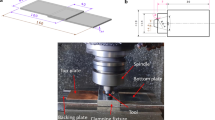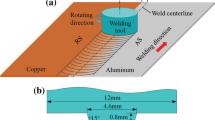Abstract
Friction spot welding is an appealing technique for joining dissimilar materials, such as aluminum and copper that have significant differences in physical and mechanical properties. To optimize the welding process, a full-factorial design was employed. It is found that in addition to the plunge depth, the interaction between the rotational speed and the plunge depth significantly influences the lap-shear strength of the Al/Cu dissimilar joints. Further investigations on macro- and microstructures show that increasing the plunge depth could deform the Cu sheet into a concave shape to form a mechanical interlocking, and thus increase the joint lap-shear strength; increasing the tool rotational speed, however, may compromise this effect because of the formed tunnel defects on the interface due to high thermal exposure.










Similar content being viewed by others
References
Savolainen K, Mononen J, Saukkonen T, Hanninen H (2006) In: 6th International Friction Stir Welding Symposium, Saint-Sauveur, Canada, CD-ROM
Bergmann JP, Petzoldt F, Schuerer R, Schneider S (2013) Solid-state welding of aluminum to copper—case studies. Weld World 57:541–550
Marya M, Marya S (2004) Interfacial microstructures and temperatures in aluminium–copper electromagnetic pulse welds. Sci Technol Weld Join 9:541–547
Liu HJ, Shen JJ, Zhou L, Zhao YQ, Liu C, Kuang LY (2011) Microstructural characterisation and mechanical properties of friction stir welded joints of aluminium alloy to copper. Sci Technol Weld Join 16:92–98
Schilling C, dos Santos JF (2004) Method and device for linking at least two adjoining work pieces by friction welding. European patent EP 1230062 B1 (WO 2001/036144)
Rosendo T, Parra B, Tier MAD, da Silva AAM, dos Santos JF, Strohaecker TR, Alcantara NG (2011) Mechanical and microstructural investigation of friction spot welded AA6181-T4 aluminium alloy. Mater Des 32:1094–1100
Zhao YQ, Liu HJ, Lin Z, Chen SX, Hou JC (2014) Microstructures and mechanical properties offriction spot welded Alclad 7B04-T74 aluminium alloy. Sci Technol Weld Join 19:617–622
Suhuddin UFH, Fischer V, dos Santos JF (2013) The thermal cycle during the dissimilar friction spot welding of aluminum and magnesium alloy. Scr Mater 68:87–90
Suhuddin U, Fischer V, Kroeff F, dos Santos JF (2014) Microstructure and mechanical properties of friction spot welds of dissimilar AA5754 Al and AZ31 Mg alloys. Mater Sci Eng A 590:384–389
Shen J, Suhuddin UFH, Cardillo MEB, dos Santos JF (2014) Eutectic structures in friction spot welding joint of aluminum alloy to copper. Appl Phys Lett 104:191901–191904
Shen J, Cardillo MEB, dos Santos JF (2014) In: 10th International Friction Stir Welding Symposium, Beijing, P.R. China, CD-ROM
Antony J (2014) Design of experiments for engineers and scientists, 2nd edn. Elsevier Ltd, Waltham
Roy RK (2010) A primer on the Taguchi method, 2nd edn. Society of Manufacturing Engineers, Dearborn
(2010) Minitab 17 Statistical Software. Minitab Inc, State College
(2012) Specification for Resistance Welding for Aerospace Applications, AWS D17.2/D17.2M: 2013, American Welding Society
Xue P, Xiao BL, Ni DR, Ma ZY (2010) Enhanced mechanical properties of friction stir welded dissimilar Al-Cu joint by intermetallic compounds. Mater Sci Eng A 527:5723–5727
Genevois C, Girard M, Huneau B, Sauvage X, Racineux G (2011) Interfacial reaction during friction stir welding of Al and Cu. Metall Mater Trans A 42:2290–2295
Fu RD, Sun RC, Zhang FC, Liu HJ (2012) Improvement of formation quality for friction stir welded joints. Weld J 91:169s–173s
Periyasamy P, Mohan B, Balasubramanian V (2012) Effect of heat input on mechanical and metallurgical properties of friction stir welded AA6061-10% SiCp MMCs. J Mater Eng Perform 21:2417–2428
Arbegast WJ (2003) Modeling friction stir joining as a metalworking process. Proceedings of Hot Deformation of Aluminum Alloys III. 313–327
Author information
Authors and Affiliations
Corresponding author
Additional information
Recommended for publication by Commission III - Resistance Welding, Solid State Welding, and Allied Joining Process
Rights and permissions
About this article
Cite this article
Cardillo, M.E.B., Shen, J., de Alcântara, N.G. et al. Effect of friction spot welding parameters on the joint formation and mechanical properties of Al to Cu. Weld World 63, 33–41 (2019). https://doi.org/10.1007/s40194-018-0632-4
Received:
Accepted:
Published:
Issue Date:
DOI: https://doi.org/10.1007/s40194-018-0632-4




